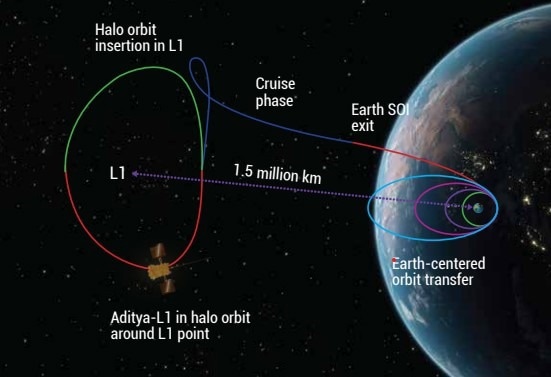India's first maiden solar mission, Aditya-L1, has started collecting data on the energetic particles emitted by the sun, a day before its departure from earth's orbit. The spacecraft deployed one of its seven onboard instruments, the Supra Thermal and Energetic Particle Spectrometer (STEPS).

Image Credit : ISRO
Aditya-L1 has begun measuring the fast-moving charged particles produced in the sun's processes. This milestone marks a significant step forward for Indian space research as it prepares to study the sun like never before.
“The sensors of the STEPS instrument have begun measuring supra-thermal and energetic ions and electrons at distances greater than 50,000 km from Earth. This data helps scientists analyse the behaviour of particles surrounding Earth,” said Indian Space Research Organisation (ISRO) via a social media post.
Aditya-L1 was successfully launched on 2 September using a Polar Satellite Launch Vehicle (PSLV-C57) from Sriharikota, days after India's historic moon landing attempt with Chandrayaan-3's Vikram Lander.
Currently, the spacecraft orbits the earth at an altitude of 256 kilometers and 121,973 kilometers. It is set to leave earth's orbit early Tuesday morning and head towards the L1 (Lagrange 1) point of the Earth-Sun system, where it will conduct further observations of the sun.
The STEPS sub-system is a vital component of the Aditya Solar Wind Particle Experiment (ASPEX) payload aboard Aditya-L1. Its role is to measure the energy spectra of various ion species present in the solar wind, specifically focusing on hydrogen, helium, carbon, nitrogen, oxygen, magnesium, and neon.
By studying these elements, scientists hope to gain insights into the sun's corona heating mechanism and better understand the dynamics of the solar wind interacting with the earth's magnetic field.
In addition to STEPS, Aditya-L1 carries six other scientific payloads designed to investigate different aspects of the sun's behaviour.
These include the Solar Ultraviolet Imaging Telescope (SUIT), the Extreme Ultraviolet Spectrometer (EUS), the Soft X-Ray Detector (SXD), the Plasma Analyser Package (PAP), the Magnetometer (MAG), and the Radio Frequency Payload (RFP). Each of these instruments plays a unique role in unlocking the mysteries of the Sun.